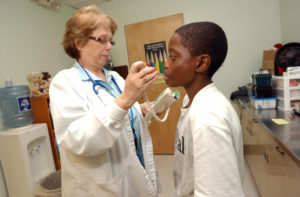
Forward by Cecilia Oregón Echeverría, Executive Director, Institute for Health Policy
Schools are great places to instill lifelong healthy behaviors in young people.
I know this firsthand, not just as a parent but as someone who worked in the school health field for over a decade and serves on the California School-Based Health Alliance’s board. I have a deep appreciation for how educators and school health professionals support a positive school climate as well as the health of students and the surrounding community, including parents, teachers, and administrators.
At Kaiser Permanente, we’re committed to nurturing health in the places where people live, work, play, and learn. This is especially important in schools, where better health boosts educational success and educational success leads to better lifelong health, employment opportunities, earning potential, and self-confidence.
Kaiser Permanente has a decades-long history of supporting work at the intersection of health and education. This has been a focus of the Institute for Health Policy’s work as well. Last year, we held a forum on addressing childhood trauma in schools that brought together stakeholders from across the country to discuss clinical, school, and community solutions.
We’re always keeping an eye out for policy solutions to advance health in communities. A new policy statement from the American Academy of Pediatrics caught our eye and we asked Hedy N. Chang, Executive Director of Attendance Works, to better explain the relationship between health and school attendance and what the new policy statement means for physicians.
Pediatricians have an important role to play in reducing chronic absenteeism
When kids aren’t healthy, they miss critical opportunities to learn by being absent from school. Missing school can cause them to fall behind their peers academically, affecting their emotional and physical health, and setting in motion a cycle of absence that can lead to worse outcomes for young people.
That’s why I was thrilled to help develop a new policy statement issued by the American Academy of Pediatrics, or AAP, about the relationship between kids’ health and chronic absenteeism in the journal, Pediatrics. The statement, “The Link Between School Attendance and Good Health,” encourages physicians to routinely ask parents about the number of missed school days in the past month at every visit for school-aged children. The answer to this question can offer key insights into children’s health and guide care decisions.
The policy statement is the culmination of three years of work by Mandy A. Allison, MD, MSPH, FAAP, and Elliott Attisha, DO, FAAP, in collaboration with leaders at the Council on School Health to gain consensus within the AAP on a policy clarifying how pediatricians can make a real difference in reducing our country’s startling rates of chronic absence.
The relationship between school attendance and health
Over the past decade, chronic absence has gone from being a virtually unknown concept to a national education metric used to measure the performance of schools in 36 states and the District of Columbia. Nearly 8 million students — in every state and at every grade level — missed 3 or more weeks of school during the 2015-16 school year. Missing just 2 days of school each month can lead kids to fall behind academically, lag behind their peers in middle school, and drop out of high school.[i]

The literature shows that adults with lower educational attainment are more likely to smoke and less likely to exercise, which are directly linked to poor health outcomes. Not earning a high school diploma is associated with increased mortality risk or lower life expectancy. Over the past 20 years, disparities in mortality rates based on educational attainment are worsening for preventable causes of death.
School absences can quickly add up when a child lacks access to care or has untreated chronic health conditions such as asthma or diabetes. In fact, up to 8% of children and teens have anxiety, which causes symptoms such as headaches, stomachaches, trouble concentrating, or refusing to go to school.
More than ever before, schools and school districts need partners, such as health providers, who can address health barriers to getting to class and create a community culture of engagement in school.
How pediatricians can help
As trusted allies, physicians can talk about the importance of reducing chronic absence and educate families on what they can do to improve their child’s attendance. Doctors can play an important role in reducing the number of days their patients are missing from school, so all children have an opportunity to learn, achieve academically, and lead a healthy life.
The AAP offers recommendations for pediatricians to follow to educate students and families about chronic absenteeism:
- Ask families about school attendance (number of missed school days in the past month) at every visit, when appropriate.
- Talk about the effects of school absences on school performance and future wellness, and talk about how absences can add up.
- Promote school attendance by using materials such as handouts, posters, or videos in the office; post information on the practice website; and praise patients and caregivers when patients are attending school regularly. Find talking points for discussing attendance with patients and families on the Attendance Works website.
- Provide firm guidance on when a child should stay home if sick, when to return to school, and how to avoid absences due to minor illness or anxiety.
The statement also offers pediatricians recommendations for patients who are missing about 10% of the school year (two or more days per month):
- Prevent, identify, and treat physical and mental health conditions that are contributing to school absences.
- Avoid writing excuses when the absence was not appropriate and avoid backdating to justify absences.
- Ask families of children with chronic health issues, such as asthma, allergies, and seizures, if they have an action plan at school. Help complete school action plans so families feel secure sending their children to school.
Take a moment now to read the AAP policy statement to find out how pediatricians and other health providers can play an important role in helping students be in class every day.
By working together, educators, communities, schools, physicians, and policy makers can create conditions that encourage all students to be in class every day, even when it isn’t easy.
Hedy N. Chang is the Executive Director of Attendance Works, a nonprofit initiative to advance student success and help close equity gaps by reducing chronic absence. Visit www.attendanceworks.org to download handouts, posters, videos, and other materials aimed at reducing student absences.
[i] Data Matters Using Chronic Absence to Accelerate Action for Student Success, by Hedy N. Chang, Lauren Bauer and Vaughan Byrnes, September 2018. *Revised December 2018.

